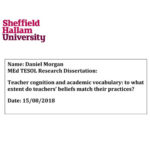Task-Based Language Learning and Teaching with Technology
Thomas, M. and Reinders, H. (2010). (Eds.). London & New York: Continuum
Reviewed by
Moonyoung Park
Iowa State University
Iowa, USA
The potential synergy between task-based language teaching and learning and the use of computer technology investigating language learners’ real-world target tasks in Computer Assisted Language Learning (CALL) has been highlighted by recent research. Task-Based Language Learning and Teaching with Technology, a new edited book by Thomas and Reinders (2010) is a response to the growing need for further research into the use of task-based language teaching and learning in CALL. It provides an in-depth exploration of the synergies between second language (L2) task-based approaches and CALL. It examines methods in which CALL plays a pivotal role in task-based language learning and teaching. It seeks to provide better understanding of how to design and implement tasks with diverse technologies to foster language learning. Although not specified by the editors, intended audience can be researchers, language teachers, and graduate students interested in TBLT and CALL. The book focuses on recent research rather than practical guidelines.
The eleven chapters of the book are divided into two parts: 1) “Research on Tasks in CALL” (Part 1) “maps out the broader theoretical questions shared by L2 task-based research and their influence on computer-mediated communication”; and 2) “Applying Technology-Mediated Tasks” (Part 2) for “design, development and application” (p. 8). Chapter 1 explains the construct of tasks and technology as an introduction and presents a justification for the whole book with a criticism of the way technology-mediated tasks have been treated in the mainstream TBLT literature.
The following five chapters (Chapters 2-6) in Part 1 lay out the diverse theoretical issues in computer-mediated task-based research. In Chapter 2, Müller-Hartmann and Ditfurth present studies on computer-mediated communication (CMC) in TBLT. In the third chapter, studies of task design in network-based CALL are explored by Peterson. Schulze, in Chapter 4, highlights the domain of intelligent CALL (ICALL), and explores its integration with task-based design. In Chapter 5, Stockwell’s study of multiple modes of CMC-based communication tasks is reported. In Chapter 6, Collentine explores the issues of task design and language learners’ linguistic complexity focusing on task conditions.
Part 2 (Chapters 7-10) highlights task-design and its implementation in diverse virtual learning environments in different contexts as well as teacher development for TBLT with technology. Hampel, in Chapter 7, reviews two studies on a three-level task development model in a virtual learning environment. In Chapter 8, Raith and Hegelheimer examine the role of Web 2.0 tools in supporting teacher development. Reeder, in Chapter 9, demonstrates a case study of ICALL software which deals with virtual reality. In Chapter 10, Hauck highlights task design and implementation in TBLT based on four-way telecollaboration projects.
Task-Based Language Learning and Teaching with Technology is written in a very accessible style although those without TBLT and CALL background may have some difficulty with the various theoretical and technical abbreviations. Compared to previous edited volumes on TBLT (e.g., Ellis, 2003; Samuda & Bygate, 2008; Van den Branden, Bygate, & Norris, 2009), this book sheds more light on the importance of technology-mediated tasks in language learning and teaching. This book excels in providing a comprehensive look into up-to-date practice, research, and theory in task-based learning. One of its primary advantages is that it explores highly diverse environments and practices incorporating cutting edge technologies with language learning and teaching.
However, this book would have benefited from the following two areas. First, the text’s strong preference for the ‘weaker’ definition of TBLT (p.4) over the so-called ‘stronger’ version as suggested by Van den Brandenet al. (2009), may help readers to recognize an already existing and developing computer-mediated activities and task in CALL. However, by widening the scope of a task definition in CALL, it gives the impression that almost anything, from an information gap activity to a fill-the-gap grammar exercise, can be called a ‘task’. Second, and more importantly, this book would be enriched by adequately making the most of the ‘stronger’ version of TBLT in which ‘task’ is proposed as a primary unit to characterize the three angles of the basic educational triangle: educational goal, pedagogic activity, and assessment which can make CALL more authentic. The research topics in the book are confined to task design environment sequencing and implementation rather than triangulating the three angles in TBLT.
Despite the minor criticisms, the book is an enlightening collection of research papers on CALL and TBLT that especially focus on task design and its implementation through the use of diverse technologies. The value of this book lies in its provision of the most recent empirical findings and theoretical foundations to realize the potential synergies of CALL and TBLT. Based on the findings from this book, I concur that the academic community will need to make every endeavor to advance technology-mediated tasks to realize the fullest sense of TBLT from ‘weaker’ to ‘stronger’ version (p. 219); from micro-level to macro-processes (p. 4) integrating computer technology, so that tasks can be more finely tuned to disciplinary, cultural, linguistic, and learner differences.
References
Chapelle, C. (2001). Computer applications in second language acquisition: Foundations for teaching, testing, and research. Cambridge: Cambridge University Press.
Ellis, R (2003). Task-based language learning and teaching. Oxford: OUP.
Samuda, V. &Bygate, M. (2008). Tasks in second language learning. Basingstoke: Pelgrave Macmillan.
Thomas, M. &Reinders, H. (2010). (Eds.). Task-Based Language Learning and Teaching with Technology. London & New York: Continuum.
Van den Branden, K., Bygate, M., & Norris, J. M. (Eds.). (2009). Task-based language teaching: A reader. Amsterdam: John Benjamins.
Bio Data
Moonyoung Park is an ESL lecturer, and research assistant while working towards a PhD in Applied Linguistics and Technology at Iowa State University. He has taught secondary and college level EFL/ESL courses in Korea, Thailand, and the US. His research interests include applications of TBLT and technologies in language learning and language testing. He is currently researching task-based aviation English training and testing and the use of automatic writing evaluation software in college ESL writing courses.








